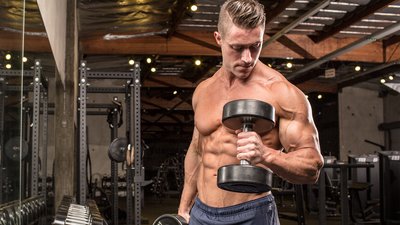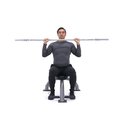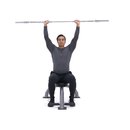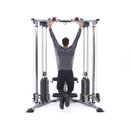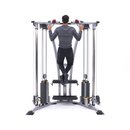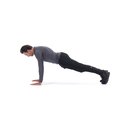Why is it some of your fellow gym rats seem to have naturally prominent veins, while you're left flat despite working tirelessly for the same look? Genetics undoubtedly play a role, but it's too late now to go back and do a better job of picking your mom and dad.
Fortunately, there are ways you can enhance your short-term vascularity. Try these nutrition, training, and supplementation tricks all true vascular beasts know!
1. Get lean
Beyond genetics, the most important factor in skin-popping veins is how lean you are. Since body fat is commonly stored right under the skin, it's literally what's between you and your veiny self. For men, this usually requires single-digit body fat; for women, probably sub-20 percent body fat, although both genders may be able to spot a tell-tale biceps vein at slightly higher percentages.
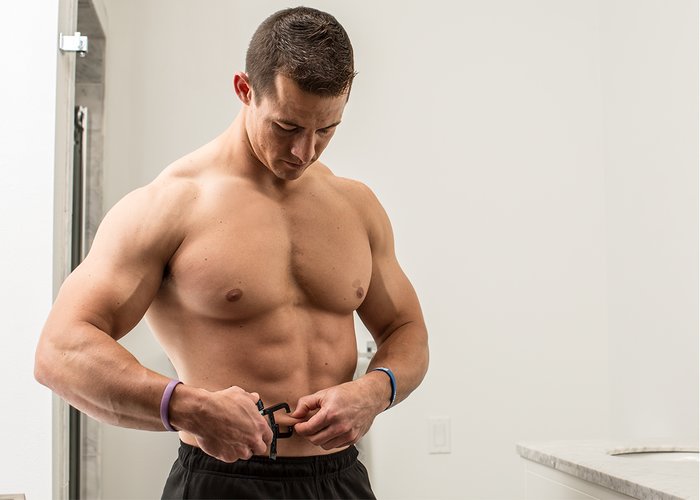
To show off skin-popping veins, start by stripping away excess body fat.
If body fat is a problem, start by figuring out the necessary number of calories you need to maintain your weight, then subtract 300-500 calories a day to create a significant deficit. Over the course of the next 10-12 weeks, aim to lose 0.5-1.5 pounds per week by incrementally—but not dramatically—reducing calories and increasing exercise.
Keep the pace steady, because if vascularity is the goal, you want to lose as little muscle mass as possible.
2. Build Muscle
Bigger muscles demand more blood—it's that simple. By training and eating with an emphasis on building muscle, your body will adapt by expanding its blood-vessel network to the newly built muscle mass.
In my experience, you're probably best off alternating between dedicated mass-building and fat-loss phases in your quest to become both leaner and more muscular.
Here’s an example of a training split that works well for building muscle:

BodyFit
$6.99/month- 2,500+ expert-created single workouts
- 3,500+ how-to exercise videos
- Detailed workout instruction
- Step-by-step workout tips
- Training at gym or at home
- Access to Workout Plans
- Access to Bodyfit App
- Store Discounts
Already have a Bodybuilding.com account with BodyFit? Sign In

What comes with BodyFit?

- Instructional Videos
Don't risk doing a workout improperly! Avoid injury and keep your form in check with in-depth instructional videos.

- How-to Images
View our enormous library of workout photos and see exactly how each exercise should be done before you give it a shot.

- Step-by-Step Instructions
Quickly read through our step-by-step directions to ensure you're doing each workout correctly the first time, every time.

BodyFit
$6.99/month- 2,500+ expert-created single workouts
- 3,500+ how-to exercise videos
- Detailed workout instruction
- Step-by-step workout tips
- Training at gym or at home
- Access to Workout Plans
- Access to Bodyfit App
- Store Discounts
Already have a Bodybuilding.com account with BodyFit? Sign In

What comes with BodyFit?

- Instructional Videos
Don't risk doing a workout improperly! Avoid injury and keep your form in check with in-depth instructional videos.

- How-to Images
View our enormous library of workout photos and see exactly how each exercise should be done before you give it a shot.

- Step-by-Step Instructions
Quickly read through our step-by-step directions to ensure you're doing each workout correctly the first time, every time.



BodyFit
$6.99/month- 2,500+ expert-created single workouts
- 3,500+ how-to exercise videos
- Detailed workout instruction
- Step-by-step workout tips
- Training at gym or at home
- Access to Workout Plans
- Access to Bodyfit App
- Store Discounts
Already have a Bodybuilding.com account with BodyFit? Sign In

What comes with BodyFit?

- Instructional Videos
Don't risk doing a workout improperly! Avoid injury and keep your form in check with in-depth instructional videos.

- How-to Images
View our enormous library of workout photos and see exactly how each exercise should be done before you give it a shot.

- Step-by-Step Instructions
Quickly read through our step-by-step directions to ensure you're doing each workout correctly the first time, every time.

BodyFit
$6.99/month- 2,500+ expert-created single workouts
- 3,500+ how-to exercise videos
- Detailed workout instruction
- Step-by-step workout tips
- Training at gym or at home
- Access to Workout Plans
- Access to Bodyfit App
- Store Discounts
Already have a Bodybuilding.com account with BodyFit? Sign In

What comes with BodyFit?

- Instructional Videos
Don't risk doing a workout improperly! Avoid injury and keep your form in check with in-depth instructional videos.

- How-to Images
View our enormous library of workout photos and see exactly how each exercise should be done before you give it a shot.

- Step-by-Step Instructions
Quickly read through our step-by-step directions to ensure you're doing each workout correctly the first time, every time.
3. Chase The Pump where You Want To See Veins
What you know as the "pump" is really just the term coined to describe cell swelling and metabolite accumulation, both of which are known to produce muscular growth.[1] By consistently chasing the pump via a combination of high-intensity lifting techniques and short rest breaks, you drive a significant amount of blood into your muscles. This bodes well for looking swole.
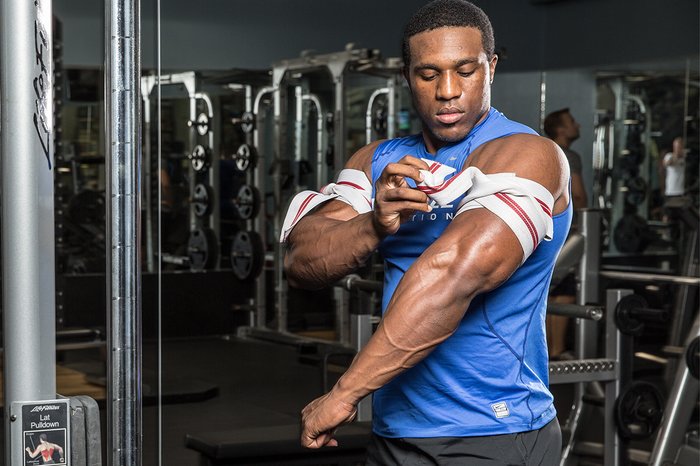
Blood-flow restriction (BFR) can help you target vascularity in a specific body part.
To specifically hone in on the pump, consider trying blood-flow restriction (BFR) in your training. BFR involves partially restricting the veins of a working muscle, which ultimately results in a pooling of blood, because the veins are unable to carry it back to the heart. This massive increase in blood usually leads to the greatest pump of your life.
If you want to see veins in a particular muscle group—say, biceps, triceps, or quads—it's a no-brainer to finish off your training day for that group with a solid pump. Choose biceps curls, triceps push-downs, or leg extensions for 4 sets of 30, 15, 15, and 15 reps using BFR, resting 30 seconds between sets. Or try Layne Norton's "Legs And Arms Blast."
4. Do Your Cardio
There are plenty of reasons to skip cardio, but one reason not to is that it may help promote more prominent veins. For starters, cardio helps to create a greater caloric deficit (assuming you're not eating more to compensate), which works to reduce body fat. The leaner you are, the more vascular you appear.
Additionally, consistent aerobic exercise increases capillary density, or the number of capillaries (tiny blood vessels) that reach your muscles.[2,3] It may even promote the formation of new capillaries.
By making cardio a staple in your exercise routine, you effectively promote more blood flow to your muscles. Over time, more veins will scratch the surface and show themselves when they're adequately filled with blood.
5. Take Supplements For The Pump
One of the major reasons blood flow is amplified during exercise is related to the production and action of nitric oxide (NO). NO is a potent vasodilator, meaning it relaxes blood vessels to increase blood-flow efficiency.
Given that NO has such a profound impact on blood flow, many supplements have been formulated to enhance its production, and ultimately your pump, during exercise. Look at your pre-workout's label or peruse online discussions, and you'll find plenty of pump supplements getting pumped up, from agmatine to glycerol to ornithine.
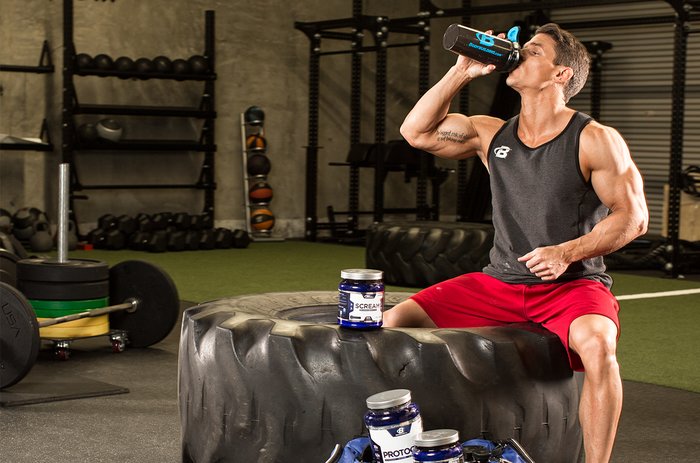
But for starters, you can't go wrong with these:
Citrulline
A few years ago, L-arginine was considered the premiere pump sup of the first order, because it's a known NO precursor. However, it's fallen out of favor because citrulline supplements have been shown to increase arginine levels more than arginine (and without the digestive distress some experience from arginine).
Dose: 6-8 grams of citrulline malate 30-60 minutes prior to your workout. For maximal results, take in one serving rather than spreading it out in multiple doses across the day.
Nitrates
The two most common dietary nitrate supplements are beetroot and pomegranate juice or extract. Both have been shown to positively impact blood flow when taken pre-workout because of their ability to act as vasodilators.[5-7]
Dose: Supplement with 1000 milligrams of pomegranate extract 30 minutes before exercise. For beetroot, what you take will vary depending on whether you drink a juice or extract, or take a powdered supplement. In either case, load with a daily dose for a week, and then take a dose before you exercise.
Creatine
Creatine acts as an osmolyte, meaning as it accumulates inside the muscle cell, fluid is drawn in as well. Supplementing with creatine can enhance cell swelling, lending a helping hand to your shirt-ripping pump and veiny exterior.
Dose: 5 grams of creatine monohydrate per day
Thermogenics
A thermogenic increases heat production in the body. As a result, more blood flow is pushed to the surface of the skin, which aids in cooling the body. Examples of thermogenic substances include caffeine, green tea, capsaicin (the component in peppers responsible for their heat), and ginger.
6. Take Your Selfie Right After Training
This may seem like a no-brainer, but all things being equal, you're probably going to look your most vascular when you're still riding a great pump from the end of your workout.
There's no scientific study that I know of measuring the length of the average pump, but 15-20 minutes is a good window to aim for. If you're trying to bust into We Mirin' or take the selfie that'll break your social network, don't wait until you're at home digesting your dinner. Click it in the gym: Nobody will bat an eye!
Because there's simply a dearth of research on the subject, I'd love hear what has worked for you in the quest for ever greater vascularity. Post your secret in the comments section below!
*These statements have not been evaluated by the Food and Drug Administration. This product is not intended to diagnose, treat, cure, or prevent any disease.
References
- Schoenfeld, B. J. (2010). The mechanisms of muscle hypertrophy and their application to resistance training.The Journal of Strength & Conditioning Research, 24(10), 2857-2872.
- Yang, H. T., Ogilvie, R. W., & Terjung, R. L. (1994). Peripheral adaptations in trained aged rats with femoral artery stenosis. Circulation Research, 74(2), 235-243.
- Saltin, B., & Gollnick, P. D. (1983). Skeletal muscle adaptability: significance for metabolism and performance.Comprehensive Physiology.
- Curis, E., Crenn, P., & Cynober, L. (2007). Citrulline and the gut. Current Opinion in Clinical Nutrition & Metabolic Care, 10(5), 620-626.
- Siervo, M., Lara, J., Ogbonmwan, I., & Mathers, J. C. (2013). Inorganic nitrate and beetroot juice supplementation reduces blood pressure in adults: a systematic review and meta-analysis. The Journal of Nutrition, 143(6), 818-826.
- Vanhatalo, A., Bailey, S. J., Blackwell, J. R., DiMenna, F. J., Pavey, T. G., Wilkerson, D. P., ... & Jones, A. M. (2010). Acute and chronic effects of dietary nitrate supplementation on blood pressure and the physiological responses to moderate-intensity and incremental exercise. American Journal of Physiology-Regulatory, Integrative and Comparative Physiology, 299(4), R1121-R1131.
- Trexler, E. T., Smith-Ryan, A. E., Melvin, M. N., Roelofs, E. J., & Wingfield, H. L. (2014). Effects of pomegranate extract on blood flow and running time to exhaustion. Applied Physiology, Nutrition, and Metabolism, 39(9), 1038-1042.


